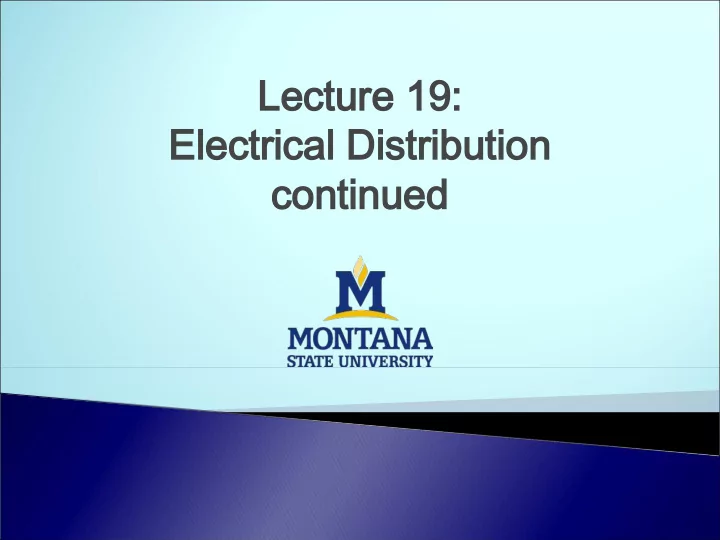

Lectur Lecture 19: e 19: Electr Electrical Distr ical Distribution ibution continued continued
Rem Remaining Cour aining Course Schedule se Schedule 11/19 Tuesday - Last day to drop courses. Grades on D2L are up to date.
Upcom Upcoming Exam ing Exam • Exam topics will be posted on D2L by end of day • Scheduled review session – Tomorrow (Thursday, 11/7) - Roberts Hall Room 102 – 6 pm • In class. Start at exactly 9 am. Go until 9:55 am. • 1 equation sheet allowed, front and back.
HW # 6 Assignm HW # 6 Assignment ent • On transformers and 3-phase circuits. • Will be up on D2L by end of day. • Due Monday 11/18 • However, will be very beneficial for test as both topics will be on exam 2. Worth doing as part of studying for test.
Electr Electrical Distr ical Distribution ibution NOTE: Book defines everything post-generation pre-use as distribution. Typically though, this system is broken-up into transmission and distribution.
Pr Prim imar ary- y-side Distr side Distribution ibution Radial Distribution Network • Power delivered along a single distribution path • Cheapest to build • Used often in rural areas • Grid disruption → shut down entire line
Pr Prim imar ary- y-side Distr side Distribution ibution Loop Distribution Network • Power delivered by loop(ed) distribution path(s) • More expensive than radial • Allows isolation of grid disruptions with minimal effect on customers
Secondar Secondary- y-side Distr side Distribution ibution Radial Distribution Network
Secondar Secondary- y-side Distr side Distribution ibution Loop Distribution Network
Residential Secondar Residential Secondary y Distr Distribution ibution • Residential customers typically get 120V/240V single- phase, 3-wire service • Taken from 1-phase of 3-phase primary distribution
Har Harmonic Distor onic Distortion tion • Distortion in sine- wave • Caused by non- linear loads – Fluorescent lights – Power electronics – Etc. • Can cause increased power losses/conductor heating
Har Harmonic Distor onic Distortion tion • North American power systems operate at 60 Hz • Harmonics multiples of supply frequency – e.g. 120 Hz, 180 Hz, etc. • Cause additional current to flow – Additional power loss – Additional heating (3-5 percent typical) in line conductors – Additional heating (big! As much as 90%) in neutral – Might need to increase neutral conductor size if large non- linear loading on distribution circuits
Conductor Conductor Sizes Sizes • Systems of Measurement – American Wire Gauge (AWG) • Ranges from #50 to #4/0 (#0000, pronounced #0000) • #50 is smallest, #4/0 is biggest • Conductors Smaller or Larger than AWG scale measured in circular mils. • Circular Mils: 2 – Unit of area given by where d is measured in mils A = d (1/1000 of an inch) – NOT equivalent to square mils
Conductor Conductor Sizes Sizes • AWG #50 equivalent to 1 cmil (circular mil) • AWG #4/0 equivalent to 212 kcmil (212,000 cmil) • In U.S., generally use AWG scale, unless conductors outside that range, then use cmils. • Note, kcmil often abbreviated MCM (means thousand circular mils) • Both used on stranded wire or solid wire. – Describes cross-sectional area of metal (solid or stranded) – Thus, stranded wire slightly larger due to spacing between strands.
Conductor Conductor Resistivity Resistivity • All conductors have some resistance (at normal temperatures at least) • Note: Resistivity – More often denoted by ρ – More often given in Ω-m
Ther Thermal Effects al Effects • As temperature increases resistivity increases • Equation in book (Chapter 9): R o = R 1 a t o R o Is operating resistance R Is resistance at 0° C a Is temperature coefficient t o Is operating temperature
Choosing Conductor Choosing Conductors Table values based on empirical thermal effects measurements on conductors.
Voltage Dr Voltage Drop in Conductor op in Conductors • NEC allows a maximum voltage drop of 3% for branch circuits • 5% for combined feeder and branch-circuit • Assume FULL load. % Voltage Drop = E 1 − E 2 E 1 E 1 Is source voltage E 2 Is load voltage
Power Power Loss Loss • NEC allows a maximum voltage drop of 3% for branch circuits • 5% for combined feeder and branch-circuit • Assume FULL load. P loss = E 1 − E 2 I 2 P loss = E 1 − E 2 R wire 2 R wire P loss = I
Questions Questions
Recommend
More recommend